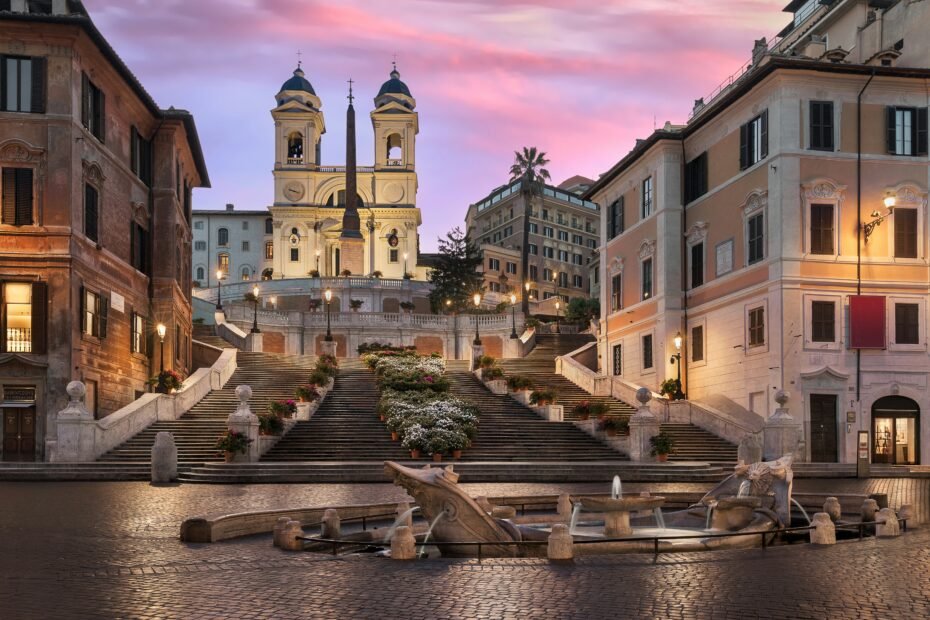Piazza di Spagna, or the Spanish Steps Square, is one of Rome’s most iconic and picturesque locations. Known for its vibrant atmosphere, elegant architecture, and cultural significance, it’s a must-visit for any tourist. Here’s everything you need to know:
Historical Background
- Name Origin:
- Named after the Spanish Embassy to the Holy See, located nearby in the 17th century.
- The area became a hub for international visitors, earning its reputation as a cosmopolitan meeting place.
- Cultural Legacy:
- A favorite spot for poets, writers, and artists during the 18th and 19th centuries.
- Attracted literary figures such as John Keats and Percy Bysshe Shelley.
Key Features and Landmarks
- The Spanish Steps (Scalinata di Trinità dei Monti)
- Description: A monumental staircase of 135 steps, built in 1723–1725 to connect the square below to the Trinità dei Monti church above.
- Designers: Francesco de Sanctis and Alessandro Specchi.
- Purpose: Funded by French diplomat Étienne Gueffier to symbolically link French and Spanish territories.
- Photography Hotspot: Offers stunning views of the piazza and is adorned with vibrant flowers in spring and summer.
- Fontana della Barcaccia (Fountain of the Boat)
- Location: At the base of the Spanish Steps.
- Design: Created in 1627–1629 by Pietro Bernini and his son Gian Lorenzo Bernini.
- Inspiration: Shaped like a half-sunken boat, inspired by the Tiber River’s flooding.
- Trinità dei Monti Church
- History: A French church built in the 16th century, known for its twin bell towers.
- Interior Highlights: Features beautiful frescoes and a dramatic altar.
- Keats-Shelley House
- Location: Adjacent to the Spanish Steps.
- Museum: Dedicated to the Romantic poets, showcasing manuscripts, letters, and artifacts.
- Significance: The house where John Keats spent his final days in 1821.
- Via dei Condotti
- Rome’s Luxury Shopping Street: Runs perpendicular to Piazza di Spagna and features high-end fashion brands like Gucci, Prada, and Valentino.
- A paradise for shoppers and window shoppers alike.
Activities and Attractions
- Relax and People-Watch:
- Sit on the Spanish Steps (note: sitting is currently discouraged or fined to preserve the site) and soak in the lively atmosphere.
- Explore the Keats-Shelley House:
- Learn about the Romantic period and its connection to Rome.
- Shopping:
- Indulge in luxury shopping or browse nearby streets like Via del Babuino and Via della Croce for boutique finds.
- Enjoy a Gelato or Coffee:
- Visit famous cafés like Antico Caffè Greco, a historic meeting place for intellectuals and artists.
Practical Information
- Best Time to Visit:
- Early morning for fewer crowds and soft lighting for photography.
- Late afternoon or evening when the square comes alive with energy.
- Getting There:
- Metro: Take Line A to the Spagna station, which opens directly onto the square.
- Bus: Several routes stop nearby.
- Accessibility:
- The square itself is accessible, but climbing the Spanish Steps may be challenging for those with mobility issues.
Tips for Tourists
- Visit the Trinità dei Monti Terrace:
- Offers panoramic views of the city and Piazza di Spagna below.
- Avoid Eating or Drinking on the Steps:
- Recent regulations prohibit sitting or consuming food/drinks on the Spanish Steps to protect the monument.
- Combine with Nearby Attractions:
- Walk to Piazza del Popolo, the Trevi Fountain, or Villa Borghese Gardens—all within a 15-minute radius.
- Evening Stroll:
- The square and steps are beautifully lit at night, offering a romantic ambiance.
Nearby Attractions
- Villa Medici:
- Located near the Trinità dei Monti church, it offers art exhibitions and beautiful gardens.
- Pincio Terrace:
- Part of Villa Borghese Gardens, this terrace offers breathtaking views of Rome at sunset.
- Trevi Fountain:
- A short walk from the piazza, perfect for making a wish.
Fun Facts
- The Spanish Steps were restored in 2016 by luxury brand Bulgari, preserving their historic beauty.
- The fountain, Fontana della Barcaccia, reportedly commemorates a boat that was stranded in the square after a flood.
- The area around Piazza di Spagna was known as the “English Ghetto” in the 18th and 19th centuries due to the influx of British expatriates and travelers.
Cultural Significance
Piazza di Spagna epitomizes Rome’s blend of history, art, and elegance. It has been a muse for painters, poets, and filmmakers for centuries. The square remains a symbol of Rome’s vibrant cultural heritage and a gathering place for visitors from around the world.
Conclusion
Piazza di Spagna is more than just a tourist destination—it’s an experience of Rome’s charm, history, and vibrancy. Whether you’re admiring the Spanish Steps, visiting the Keats-Shelley House, or enjoying a leisurely stroll, the piazza offers something special for everyone.
